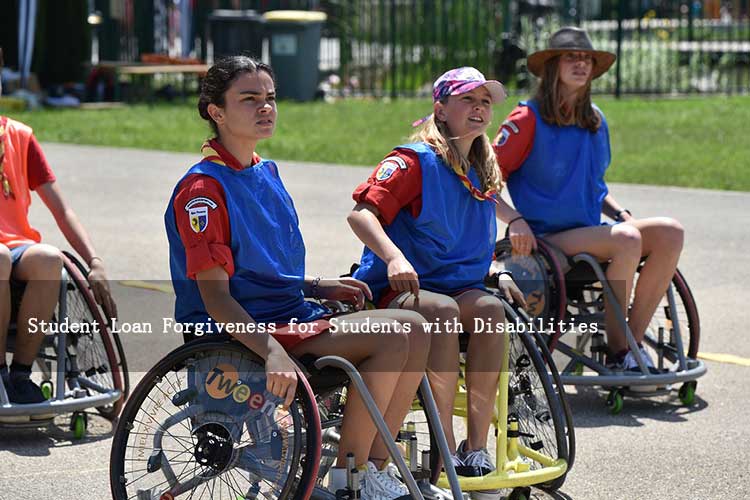
Managing student loans can be quite a challenge for anyone, but it can be especially tough for borrowers with disabilities. Thankfully, the U.S. Department of Education has a program called the Total and Permanent Disability (TPD) Discharge that offers Student Loan Forgiveness for Students with Disabilities. This program can provide essential relief by wiping out federal student loan debts for eligible individuals. It’s important for borrowers to grasp the eligibility requirements, the application process, and any potential tax consequences.
In this article, we’ll explore everything you need to know about qualifying for student loan forgiveness for individuals with disabilities and how to navigate the application process, along with helpful tips to make it easier.
What Is Student Loan Forgiveness for Students with Disabilities?
The Total and Permanent Disability (TPD) Discharge is a federal loan forgiveness program designed specifically for borrowers who can no longer maintain gainful employment due to a disability. The program applies to several types of federal loans, including:
- Direct Loans
- Federal Family Education Loans (FFEL)
- Perkins Loans
- TEACH Grant obligations
The TPD Discharge program forgives the outstanding balance of these loans, relieving eligible borrowers from repayment requirements. This program ensures that individuals with significant disabilities are not burdened by student loan debt they can no longer afford to repay.
Who Is Eligible for Student Loan Forgiveness for Students with Disabilities?
To qualify for student loan forgiveness for students with disabilities, you must meet the government’s criteria for total and permanent disability. This typically means that your disability prevents you from working and is expected to last indefinitely. There are three ways to demonstrate eligibility:
1. Veterans Affairs (VA) Documentation
- If you are a veteran and the Department of Veterans Affairs (VA) has determined that you have a service-connected disability that is 100% disabling, you can qualify for TPD Discharge.
- Veterans can submit their VA disability award letter as part of the application process.
2. Social Security Administration (SSA) Documentation
- Borrowers receiving Social Security Disability Insurance (SSDI) or Supplemental Security Income (SSI) benefits may also be eligible.
- The SSA must confirm that your next disability review will not occur for at least five to seven years from your last review, which signifies a long-term or permanent disability.
3. Physician’s Certification
- If you do not qualify through the VA or SSA, you can still apply with certification from a licensed physician.
- Your doctor must confirm that your disability is expected to last for at least 60 months or result in death.
How to Apply for Student Loan Forgiveness for Students with Disabilities
The application process for student loan forgiveness for students with disabilities can seem daunting, but following these steps will help you navigate it successfully:
1. Submit a TPD Discharge Application
- Download the TPD Discharge application form from the Federal Student Aid website.
- Complete the relevant sections, depending on whether you are applying through VA, SSA, or physician certification.
2. Provide Supporting Documentation
- If applying through the VA or SSA, attach your relevant disability documentation or letter.
- If using a physician’s certification, have your doctor fill out the required sections of the application form. Ensure they provide a detailed statement about your disability’s impact on your ability to work.
3. Send the Application to Nelnet
- Nelnet is the designated servicer that handles TPD Discharge applications. Submit your completed application and supporting documents by mail or fax to: Nelnet Total and Permanent Disability Discharge
P.O. Box 87130
Lincoln, NE 68501-7130 - You can also fax your application to 303-696-5250.
4. Monitor Your Application Status
- After submitting your application, Nelnet will notify you once your documents have been received.
- During the review process, Nelnet may contact you if additional documentation or clarification is needed. Make sure to respond promptly to avoid delays.
What Happens After Approval?
Once your application for student loan forgiveness for students with disabilities is approved, your loan obligations will be discharged. Here’s what to expect after approval:
- Loan Cancellation: Your outstanding student loan balance will be eliminated, and you will no longer need to make payments.
- Monitoring Period: In some cases, there is a three-year monitoring period. During this time, the Department of Education may monitor your earnings and disability status to ensure you still meet the eligibility requirements.
- Reinstatement Risk: If your income exceeds certain thresholds or you become ineligible for disability benefits during the monitoring period, your loans could be reinstated. It’s crucial to keep your financial status aligned with program guidelines.
Are There Tax Implications for Loan Forgiveness?
One important consideration for borrowers is whether loan forgiveness under the TPD program is taxable. Prior to 2018, discharged student loans were considered taxable income by the IRS. However, thanks to the Tax Cuts and Jobs Act, loans forgiven between 2018 and 2025 are not subject to federal income tax.
Some states, however, may still treat forgiven loans as taxable income. It’s essential to check your state’s tax laws or consult a tax professional to understand if you will owe state taxes after your loans are discharged.
What If My Application Is Denied?
If your application for student loan forgiveness for students with disabilities is denied, don’t lose hope. You can take the following actions:
- Appeal the Decision: You can submit an appeal with additional documentation or clarification of your disability status.
- Apply Again with Physician Certification: If you initially applied with VA or SSA documentation and were denied, you can try submitting a new application with a physician’s certification.
If you are denied multiple times, contact your loan servicer or an attorney who specializes in student loan law to explore additional options.
Alternatives to Student Loan Forgiveness for Students with Disabilities
If you do not qualify for the TPD Discharge, other options are available to help manage your student loan payments:
1. Income-Driven Repayment (IDR) Plans
IDR plans adjust your monthly loan payments based on your income and family size, making it easier to manage your debt if you’re on a limited income.
2. Deferment or Forbearance
Both deferment and forbearance allow you to temporarily pause your student loan payments. If you’re facing a temporary financial hardship or recovering from a medical issue, these options may provide short-term relief.
3. State and Employer Loan Forgiveness Programs
Some states and employers offer student loan forgiveness programs for individuals with disabilities or those working in specific professions, such as healthcare or education.
Key Takeaways
- Student loan forgiveness for students with disabilities is available through the TPD Discharge program for borrowers unable to work due to a permanent disability.
- Eligibility can be established through VA, SSA, or physician certification.
- Approved borrowers will have their loans discharged, with no federal tax obligations until 2025.
- Alternatives like IDR plans, deferment, or other forgiveness programs are available for those who do not qualify for TPD Discharge.
Conclusion
Managing student loan debt can feel daunting, particularly for those with disabilities. Fortunately, the Student Loan Forgiveness for Students with Disabilities provides essential support for those finding it hard to keep up with their loans. By familiarizing yourself with the eligibility requirements and adhering to the guidelines in this guide, you can enhance your likelihood of receiving approval and achieve some financial relief. If you find that you don’t meet the criteria, consider looking into other repayment options to help lighten your financial load and keep your student loans manageable.



